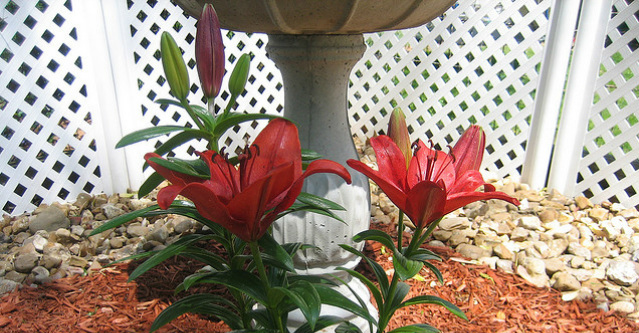How to Use Mulch in the Garden
If you are new to gardening, you have probably heard other gardeners talking about mulching and have probably seen those big bags of decorative mulch for sale in the home improvement center. If you are anything like I was, you may be wondering exactly how you use mulch in the garden. That, of course, depends on what you are growing and the purpose of the mulch. For ornamental or specimen plants, those bags of decorative mulch can enhance their appearance, reduce weeds and retain moisture, but when it comes to the vegetable garden, there are better choices for mulching.
Organic Mulch
Organic mulch refers to mulch that is made from plant materials and includes grass clipping, hay or straw, leaf mold or wood chips. Organic mulch breaks down over time and enriches your soil. Organic mulch typically keeps soil cool, retains moisture and suppresses weeds.
Inorganic Mulch
Inorganic mulch is produced from man-made or non-organic material. This includes landscape fabric, plastic or stone. Inorganic mulch also retains moisture and suppresses weeds, but it also tends to keep the soil warm.
Choosing Mulch for Your Garden
Grass Clippings
Many gardeners prefer to use grass clippings to mulch the area under cool-season crops such as peas, broccoli, onions, and carrots. Not only is it readily available and free, grass clippings keep the soil cool and protect cool-season crops from the negative effects warm soil has on their roots. Decaying grass clippings may temporarily reduce the amount of nitrogen in the soil.
Straw or Hay
Straw or hay is inexpensive and easy to use, but may harbor seeds that will sprout and grow in your garden. Straw and hay are best used in the fall as a winter mulch to protect perennials from winter damage. Some gardeners prefer to use hay or straw mulch for potatoes and allow the young tubers to grow under the hay.
Leaves
Chopped leaves make effective organic mulch and add organic matter to the soil. Layer leaves two to three inches thick to retain moisture and reduce weeds. Unchopped leaves may clump and become a slimy mass. Run leaves through a mulcher or let them begin to decompose before adding them to the garden as mulch.
Pine Needles, Bark and Wood Chips
Although pine needles and wood products work well as a mulch for ornamental plants, trees and shrubs, they are not recommended for vegetable gardens. As wood products and pine needles decompose, they tie up nitrogen in the soil and increase acidity.
Black or Red Plastic
Black or red plastic is often used under tomatoes and peppers and may even increase yields. Plastic draws the heat of the sun and keeps the soil warm. It is particularly useful in northern gardens where soil temperatures may be too low for optimum growth in tomatoes or peppers.
Choosing the right mulch for your garden vegetables reduces the amount of time spent on weeding and cultivating, reduces the need for supplemental watering and helps to maintain consistent soil temperatures. The type of mulch you use, depends on the plants you are growing and your personal preferences.
Organic Mulch
Organic mulch refers to mulch that is made from plant materials and includes grass clipping, hay or straw, leaf mold or wood chips. Organic mulch breaks down over time and enriches your soil. Organic mulch typically keeps soil cool, retains moisture and suppresses weeds.
Inorganic Mulch
Inorganic mulch is produced from man-made or non-organic material. This includes landscape fabric, plastic or stone. Inorganic mulch also retains moisture and suppresses weeds, but it also tends to keep the soil warm.
Choosing Mulch for Your Garden
Grass Clippings
Many gardeners prefer to use grass clippings to mulch the area under cool-season crops such as peas, broccoli, onions, and carrots. Not only is it readily available and free, grass clippings keep the soil cool and protect cool-season crops from the negative effects warm soil has on their roots. Decaying grass clippings may temporarily reduce the amount of nitrogen in the soil.
Straw or Hay
Straw or hay is inexpensive and easy to use, but may harbor seeds that will sprout and grow in your garden. Straw and hay are best used in the fall as a winter mulch to protect perennials from winter damage. Some gardeners prefer to use hay or straw mulch for potatoes and allow the young tubers to grow under the hay.
Leaves
Chopped leaves make effective organic mulch and add organic matter to the soil. Layer leaves two to three inches thick to retain moisture and reduce weeds. Unchopped leaves may clump and become a slimy mass. Run leaves through a mulcher or let them begin to decompose before adding them to the garden as mulch.
Pine Needles, Bark and Wood Chips
Although pine needles and wood products work well as a mulch for ornamental plants, trees and shrubs, they are not recommended for vegetable gardens. As wood products and pine needles decompose, they tie up nitrogen in the soil and increase acidity.
Black or Red Plastic
Black or red plastic is often used under tomatoes and peppers and may even increase yields. Plastic draws the heat of the sun and keeps the soil warm. It is particularly useful in northern gardens where soil temperatures may be too low for optimum growth in tomatoes or peppers.
Choosing the right mulch for your garden vegetables reduces the amount of time spent on weeding and cultivating, reduces the need for supplemental watering and helps to maintain consistent soil temperatures. The type of mulch you use, depends on the plants you are growing and your personal preferences.
